The Radeon HD 4850 & 4870: AMD Wins at $199 and $299
by Anand Lal Shimpi & Derek Wilson on June 25, 2008 12:00 AM EST- Posted in
- GPUs
Building a RV770
We did this with NVIDIA's GT200 and it seemed to work out well, so let's start at the most basic level with AMD's RV770. Meet the Stream Processing Unit:
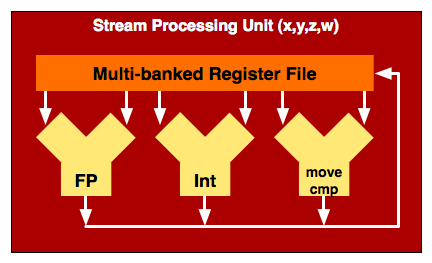
AMD's Stream Processing Unit is very similar to NVIDIA's SP in G80/G92/GT200, so similar in fact that I drew them the same way. Keep in mind that the actual inner workings of one of these units is far more complex than three ALUs but to keep things simple and consistent that's how I drew it (the actual hardware is a fused FP MUL + ADD unit, for those who care). AMD has four of these stream processing units in a processor block and they are called x, y, z or w units.
There's a fifth unit called a t-unit (the t stands for transcendental, meaning the type of operations it is capable of processing):

The t-unit can do everything a x,y,z or w-unit can do, but it also can do transcendental operations (represented by the SFU block in the diagram above). NVIDIA has the same functionality, it simply chooses to expose it in a different way (which we'll get to shortly). AMD considers each one of these units (x,y,z,w and t) a processing unit, and the RV770 has 800 of them (the RV670 had 320).
AMD pairs four of these stream processing units (x,y,z and w) with a t-unit and puts them together as a block, which I have decided to call a Streaming Processor (SP):

The area in red is actually the SP, but unlike one of NVIDIA's SPs, one of AMD's can handle up to five instructions at the same time. The only restriction here is that all five units have to be working on the same thread.
AMD then groups 16 of these SPs into something they like to call a SIMD core (AMD has less confusing, but far worse names for its architectural elements than NVIDIA):
|
AMD's SIMD Core
|
NVIDIA's SM
|
 |
 |
A SIMD core is very similar to NVIDIA's SM with a couple of exceptions:
1) There are more SPs in AMD's SIMD Core (16 vs 8)
2) The SPs are wider and can process, at peak, 5x the number of instructions as NVIDIA's SPs
3) The Instruction and Constant caches are not included in the SIMD core, AMD places them further up the ladder.
4) AMD pairs its texture units and texture cache with its SPs at the SIMD core level, while NVIDIA does it further up the ladder.
5) See the two SFUs in NVIDIA's SM? While NVIDIA has two very fast Special Function Units in its SM, AMD equips each SP with its own SFU. It's unclear which approach is actually faster given that we don't know the instruction latency or throughput of either SFU.
Note that at this point, the RV770 is really no different than the RV670 (the GPU used in the Radeon HD 3870). The next step is where AMD and NVIDIA really diverge; while NVIDIA's GT200 takes three SMs and groups them into a Texture/Processing Cluster (TPC) and then arranging 10 TPCs on its chip, AMD simply combines 10 SIMD cores:
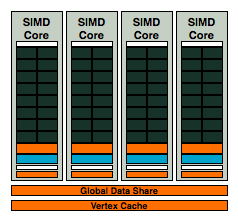
AMD's RV670
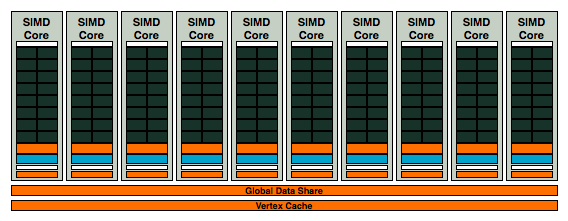
10 SIMD cores at your disposal in AMD's RV770, this is how AMD goes from competitive, to downright threatening
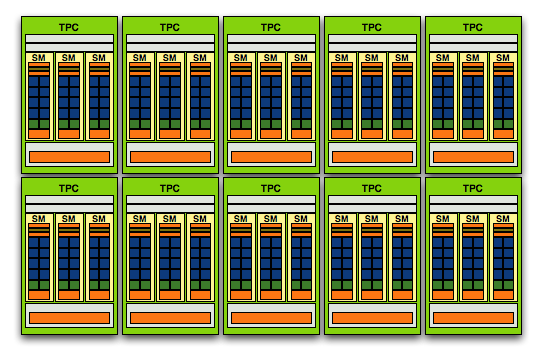
NVIDIA's GT200 Streaming Processor Array (SPA), it has fewer execution resources but more encapsulation around them, the focus here is on thread management
With 10 SIMD cores the RV770, it has 2.5x the number of execution units as a RV670. It even has more theoretical processing power than NVIDIA's GT200. If you just look at the number of concurrent instructions that can be processed on RV770 vs. GT200, the RV770's 800 execution units to GT200's 240 (+ 60 SFUs) is in a completely different league.
| NVIDIA GT200 | AMD RV770 | AMD RV670 | |
| SP Issue Width | 1-way | 5-way | 5-way |
| # of SPs | 240 | 160 | 64 |
| Worst Case Dependent Instruction Throughput | 240 | 160 | 64 |
| Maximum Scalar Instruction Throughput | 480* | 800 | 320 |
We'll be talking about efficiency and resource utilization in the coming pages, but immediately you'll notice that the RV770 (like the RV670 and R600 that came before it) has the potential to be slower than NVIDIA's architectures or significantly faster, depending entirely on how instruction or thread heavy the workload is. NVIDIA's architecture prefers tons of simple threads (one thread per SP) while AMD's architecture wants instruction heavy threads (since it can work on five instructions from a single thread at once).
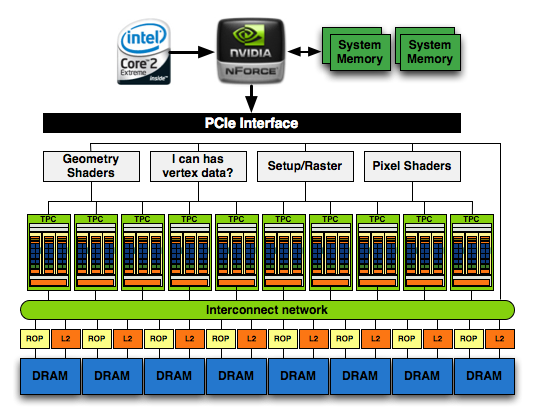
NVIDIA's GeForce GTX 280
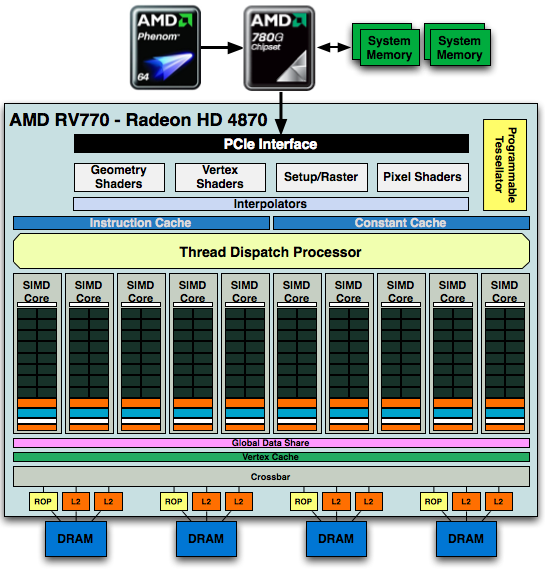
AMD's Radeon HD 4870
The full GPU is pretty impressive:
1) See the Instruction and Constant Caches up top? NVIDIA includes them in each SM while AMD seems to include them outside of the SIMD core clusters.
2) The RV770 only has four 64-bit memory controllers compared to the eight in GT200
3) The Programmable Tessellator is left over from the Xbox 360's GPU (and R600/RV670), unfortunately it is unused by most developers as there is no DirectX support for it yet.
4) AMD has dedicated hardware attribute interpolators, something NVIDIA's hardware shares with its special function units (SFUs).
Other than the differences we mentioned above, AMD's architecture is similar in vain to NVIDIA's, there are just a handful of design choices that set the two apart. Just like NVIDIA took its G80/G92 architecture and made it larger, AMD did the same with RV770 - it took RV670 and more than doubled its execution resources.
AMD took a bigger leap with RV770 from RV670 than NVIDIA did from G80/G92 to GT200, but it makes sense given that AMD had to be more competitive than it even was in the last generation.










215 Comments
View All Comments
araczynski - Wednesday, June 25, 2008 - link
...as more and more people are hooking up their graphics cards to big HDTVs instead of wasting time with little monitors, i keep hoping to find out whether the 9800gx2/4800 lines have proper 1080p scaling/synching with the tvs? for example the 8800 line from nvidia seems to butcher 1080p with tv's.anyone care to speak from experience?
DerekWilson - Wednesday, June 25, 2008 - link
i havent had any problem with any modern graphics card (dvi or hdmi) and digital hdtvsi haven't really played with analog for a long time and i'm not sure how either amd or nvidia handle analog issues like overscan and timing.
araczynski - Wednesday, June 25, 2008 - link
interesting, what cards have you worked with? i have the 8800gts512 right now and have the same problem as with the 7900gtx previously. when i select 1080p for the resolution (which the drivers recognize the tv being capable of as it lists it as the native resolution) i get a washed out messy result where the contrast/brightness is completely maxed (sliders do little to help) as well as the whole overscan thing that forces me to shrink the displayed image down to fit the actual tv (with the nvidia driver utility). 1600x900 can usually be tolerable in XP (not in vista for some reason) and 1080p is just downright painful.i suppose it could by my dvi to hdmi cable? its a short run, but who knows... i just remember reading a bit on the nvidia forums that this is a known issue with the 8800 line, so was curious as to how the 9800 line or even the 4800 line handle it.
but as the previous guy mentioned, ATI does tend to do the TV stuff much better than nvidia ever did... maybe 4850 crossfire will be in my rig soon... unless i hear more about the 4870x2 soon...
ChronoReverse - Wednesday, June 25, 2008 - link
ATI cards tend to do the TV stuff properlyFXi - Wednesday, June 25, 2008 - link
If Nvidia doesn't release SLI to Intel chipsets (and on a $/perf ratio it might not even help if it does), the 4870 in CF is going to stop sales of the 260's into the ground.Releasing SLI on Intel and easing the price might help ease that problem, but of course they won't do it. Looks like ATI hasn't just come back, they've got a very, very good chip on their hands.
Powervano - Wednesday, June 25, 2008 - link
Anand and DerekWhat about temperatures of HD4870 under IDLE and LOAD? page 21 only shows power comsumption.
iwodo - Wednesday, June 25, 2008 - link
Given how ATI architecture greatly rely on maximizing its Shader use, wouldn't driver optimization be much more important then Nvidia in this regard?And is ATI going about Nvidia CUDA? Given CUDA now have a much bigger exposure then how ever ATI is offering.. CAL or CTM.. i dont even know now.
DerekWilson - Wednesday, June 25, 2008 - link
getting exposure for AMD's own GPGPU solutions and tools is going to be though, especially in light of Tesla and the momentum NVIDIA is building in the higher performance areas.they've just got to keep at it.
but i think their best hope is in Apple right now with OpenCL (as has been mentioned above) ...
certainly AMD need to keep pushing their GPU compute solutions, and trying to get people to build real apps that they can point to (like folding) and say "hey look we do this well too" ...
but in the long term i think NVIDIA's got the better marketing there (both to consumers and developers) and it's not likely going to be until a single compute language emerges as the dominant one that we see level competition.
Amiga500 - Wednesday, June 25, 2008 - link
AMD are going to continue to use the open source alternative - Open CL.In a relatively fledgling program environment, it makes all the sense in the world for developers to use the open source option, as compatibility and interoperability can be assured, unlike older environments like graphics APIs.
OSX v10.6 (snow lepoard) will use Open CL.
DerekWilson - Wednesday, June 25, 2008 - link
OpenCL isn't "open source" ...Apple is trying to create an industry standard heterogeneous compute language.
What we need is a compute language that isn't "owned" by a specific hardware maker. The problem is that NVIDIA has the power to redefine the CUDA language as it moves forward to better fit their architecture. Whether they would do this or not is irrelevant in light of the fact that it makes no sense for a competitor to adopt the solution if the possibility exists.
If NVIDIA wants to advance the industry, eventually they'll try and get CUDA ANSI / ISO certified or try to form an industry working group to refine and standardize it. While they have the exposure and power in CUDA and Tesla they won't really be interested in doing this (at least that's our prediction).
Apple is starting from a standards centric view and I hope they will help build a heterogeneous computing language that combines the high points of all the different solutions out there now into something that's easy to develop or and that can generate code to run well on all architectures.
but we'll have to wait and see.